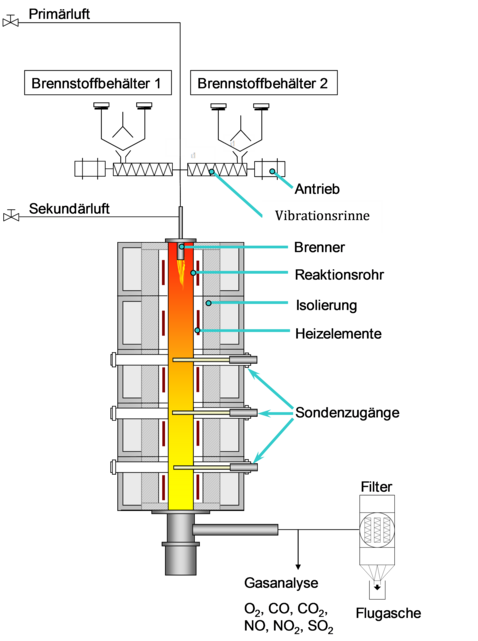Entrained flow reactor
The entrained flow reactor is used for fundamental combustion investigations of solid fuels under exactly defined conditions. This is reached through electric heating elements, which can heat the combustion tube to up to 1600 °C. The processes in the combustion tube can be analyzed by means of optical probes and methods.
The fuels are investigated regarding:
- Combustion process
- Pollutant formation
- Pollution/Slagging
- Corrosion
The reactor serves the investigation of combustion processes at temperatures above 1300 °C, and the development of suitable process concepts. Fuels that should be investigated are agricultural waste, straw, energy plants, and prepared biomass from torrefaction and hydrothermal carbonization (grass cuttings, landscaping materials). These fuels can be highly problematic when combusted and gasified in conventional facility concepts. At temperatures above the ash softening and with low excess air, one produces a fluid slag layer independently of the alkaline content (K, Ca, Mg). This protects the combustion room from corrosion and binds particles and alkalis. Due to the high combustion temperature, a very good burnout can be expected, with low levels of CO, tar, and CxHy emissions. The danger of excessive nitrogen oxide formation due to thermal NOx and fuel-N must be handled through air grading. Through the air grading and lowest possible levels of primary air, the formation of NO can be avoided. More complicated is the design of the combustion chamber and a heat exchanger. For this purpose, a metal or ceramic heat exchange system, although preferably metal, can be applied for emissions with approximately 1200 °C. Power generation in the combustion process is made possible through the flow of compressed air through hot air turbines. Currently, micro gas turbines with the production range of between 60-200 kW are available for this purpose. This technology serves to close the existing gap in small decentralized power generation plants in the production range of < 500 kW. Optimization through an extra power generation step using ORC is possible. The temperature of the combustion should be between 950 and 1400 °C.
